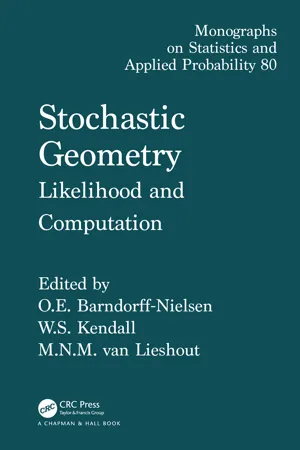
- 408 pages
- English
- ePUB (mobile friendly)
- Available on iOS & Android
eBook - ePub
About this book
Stochastic geometry involves the study of random geometric structures, and blends geometric, probabilistic, and statistical methods to provide powerful techniques for modeling and analysis. Recent developments in computational statistical analysis, particularly Markov chain Monte Carlo, have enormously extended the range of feasible applications. Stochastic Geometry: Likelihood and Computation provides a coordinated collection of chapters on important aspects of the rapidly developing field of stochastic geometry, including:
o a "crash-course" introduction to key stochastic geometry themes
o considerations of geometric sampling bias issues
o tesselations
o shape
o random sets
o image analysis
o spectacular advances in likelihood-based inference now available to stochastic geometry through the techniques of Markov chain Monte Carlo
Frequently asked questions
Yes, you can cancel anytime from the Subscription tab in your account settings on the Perlego website. Your subscription will stay active until the end of your current billing period. Learn how to cancel your subscription.
At the moment all of our mobile-responsive ePub books are available to download via the app. Most of our PDFs are also available to download and we're working on making the final remaining ones downloadable now. Learn more here.
Perlego offers two plans: Essential and Complete
- Essential is ideal for learners and professionals who enjoy exploring a wide range of subjects. Access the Essential Library with 800,000+ trusted titles and best-sellers across business, personal growth, and the humanities. Includes unlimited reading time and Standard Read Aloud voice.
- Complete: Perfect for advanced learners and researchers needing full, unrestricted access. Unlock 1.4M+ books across hundreds of subjects, including academic and specialized titles. The Complete Plan also includes advanced features like Premium Read Aloud and Research Assistant.
We are an online textbook subscription service, where you can get access to an entire online library for less than the price of a single book per month. With over 1 million books across 1000+ topics, we’ve got you covered! Learn more here.
Look out for the read-aloud symbol on your next book to see if you can listen to it. The read-aloud tool reads text aloud for you, highlighting the text as it is being read. You can pause it, speed it up and slow it down. Learn more here.
Yes! You can use the Perlego app on both iOS or Android devices to read anytime, anywhere — even offline. Perfect for commutes or when you’re on the go.
Please note we cannot support devices running on iOS 13 and Android 7 or earlier. Learn more about using the app.
Please note we cannot support devices running on iOS 13 and Android 7 or earlier. Learn more about using the app.
Yes, you can access Stochastic Geometry by Wilfrid S. Kendall in PDF and/or ePUB format, as well as other popular books in Mathematics & Analytic Geometry. We have over one million books available in our catalogue for you to explore.
Information
CHAPTER 1
A crash course in stochastic geometry
Adrian J. Baddeley
University of Western Australia
This chapter aims to give the reader a rapid introduction to the main ideas of stochastic geometry. It is not a literature review but rather a very selective presentation of some of the key points.
1.1 Introduction
Stochastic geometry is the study of random processes whose outcomes are geometrical objects or spatial patterns, that is, random subsets of ℝd or some other given space. It has applications to digital image analysis, spatial statistics and stereology, and connections with many areas of probability and statistics. One of its most appealing, direct applications is to the analysis of spatial patterns, such as those shown in Figures 1.1 and 1.2.


The earliest examples of random geometry were parlour games in which a coin or stick is thrown haphazardly onto a flat surface, and the gamble depends on the final location of the object thrown. From this developed a theory of geometrical probability, concerned mainly with problems in which rigid geometrical figures are randomly positioned in the plane according to an appropriate uniform distribution or uniform Poisson process. This is capable of modelling patterns such as those in Figure 1.1. This classical theory, closely related to integral geometry, reveals many fascinating connections between convex geometry and probability. See Kendall and Moran (1963), Santaló (1976), Schneider and Weil (1992), Solomon (1978).
Modern stochastic geometry handles random subsets of arbitrary form, for example, the zero set of a random function, or a randomly-generated fractal. It also deals with very general classes of probability models, such as stationary random sets in ℝd. These are capable of modelling spatial patterns such as that in Figure 1.2. See Harding and Kendall (1974), Matheron (1975), Mecke et al. (1990), Stoyan et al. (1987), Stoyan and Stoyan (1992), Weil and Wieacker (1993) and Cressie (1991, cha...
Table of contents
- Cover
- Title Page
- Copyright Page
- Table of Contents
- Contributors
- Preface
- 1 Crash course in stochastic geometry
- 2 Sampling and censoring
- 3 Likelihood inference for spatial point processes
- 4 Markov chain Monte Carlo and spatial point processes
- 5 Topics in Voronoi and Johnson-Mehl tessellations
- 6 Mathematical morphology
- 7 Random closed sets
- 8 General shape and registration analysis
- 9 Nash inequalities
- Index